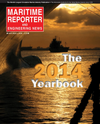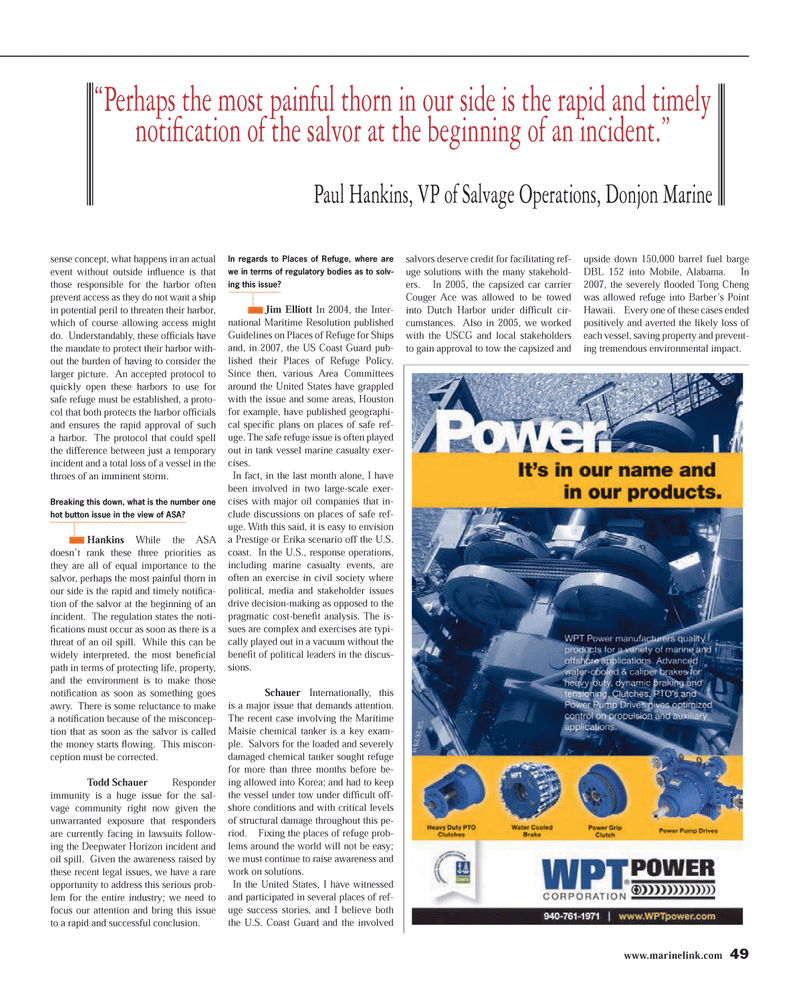
Page 49: of Maritime Reporter Magazine (June 2014)
Annual World Yearbook
Read this page in Pdf, Flash or Html5 edition of June 2014 Maritime Reporter Magazine
www.marinelink.com 49 sense concept, what happens in an actual event without outside in? uence is that those responsible for the harbor often prevent access as they do not want a ship in potential peril to threaten their harbor, which of course allowing access might do. Understandably, these of? cials have the mandate to protect their harbor with- out the burden of having to consider the larger picture. An accepted protocol to quickly open these harbors to use for safe refuge must be established, a proto- col that both protects the harbor of? cials and ensures the rapid approval of such a harbor. The protocol that could spell the difference between just a temporary incident and a total loss of a vessel in the throes of an imminent storm.
Breaking this down, what is the number one hot button issue in the view of ASA?
Hankins While the ASA doesn’t rank these three priorities as they are all of equal importance to the salvor, perhaps the most painful thorn in our side is the rapid and timely noti? ca- tion of the salvor at the beginning of an incident. The regulation states the noti- ? cations must occur as soon as there is a threat of an oil spill. While this can be widely interpreted, the most bene? cial path in terms of protecting life, property, and the environment is to make those noti? cation as soon as something goes awry. There is some reluctance to make a noti? cation because of the misconcep- tion that as soon as the salvor is called the money starts ? owing. This miscon- ception must be corrected.
Todd Schauer Responder immunity is a huge issue for the sal- vage community right now given the unwarranted exposure that responders are currently facing in lawsuits follow- ing the Deepwater Horizon incident and oil spill. Given the awareness raised by these recent legal issues, we have a rare opportunity to address this serious prob- lem for the entire industry; we need to focus our attention and bring this issue to a rapid and successful conclusion.
In regards to Places of Refuge, where are we in terms of regulatory bodies as to solv- ing this issue?
Jim Elliott In 2004, the Inter- national Maritime Resolution published
Guidelines on Places of Refuge for Ships and, in 2007, the US Coast Guard pub- lished their Places of Refuge Policy.
Since then, various Area Committees around the United States have grappled with the issue and some areas, Houston for example, have published geographi- cal speci? c plans on places of safe ref- uge. The safe refuge issue is often played out in tank vessel marine casualty exer- cises.
In fact, in the last month alone, I have been involved in two large-scale exer- cises with major oil companies that in- clude discussions on places of safe ref- uge. With this said, it is easy to envision a Prestige or Erika scenario off the U.S. coast. In the U.S., response operations, including marine casualty events, are often an exercise in civil society where political, media and stakeholder issues drive decision-making as opposed to the pragmatic cost-bene? t analysis. The is- sues are complex and exercises are typi- cally played out in a vacuum without the bene? t of political leaders in the discus- sions.
Schauer Internationally, this is a major issue that demands attention.
The recent case involving the Maritime
Maisie chemical tanker is a key exam- ple. Salvors for the loaded and severely damaged chemical tanker sought refuge for more than three months before be- ing allowed into Korea; and had to keep the vessel under tow under dif? cult off- shore conditions and with critical levels of structural damage throughout this pe- riod. Fixing the places of refuge prob- lems around the world will not be easy; we must continue to raise awareness and work on solutions.
In the United States, I have witnessed and participated in several places of ref- uge success stories, and I believe both the U.S. Coast Guard and the involved salvors deserve credit for facilitating ref- uge solutions with the many stakehold- ers. In 2005, the capsized car carrier
Couger Ace was allowed to be towed into Dutch Harbor under dif? cult cir- cumstances. Also in 2005, we worked with the USCG and local stakeholders to gain approval to tow the capsized and upside down 150,000 barrel fuel barge
DBL 152 into Mobile, Alabama. In 2007, the severely ? ooded Tong Cheng was allowed refuge into Barber’s Point
Hawaii. Every one of these cases ended positively and averted the likely loss of each vessel, saving property and prevent- ing tremendous environmental impact. “Perhaps the most painful thorn in our side is the rapid and timely notifi cation of the salvor at the beginning of an incident.”
Paul Hankins, VP of Salvage Operations, Donjon Marine
MR #6 (40-49).indd 49 6/9/2014 11:17:30 AM

 48
48

 50
50
